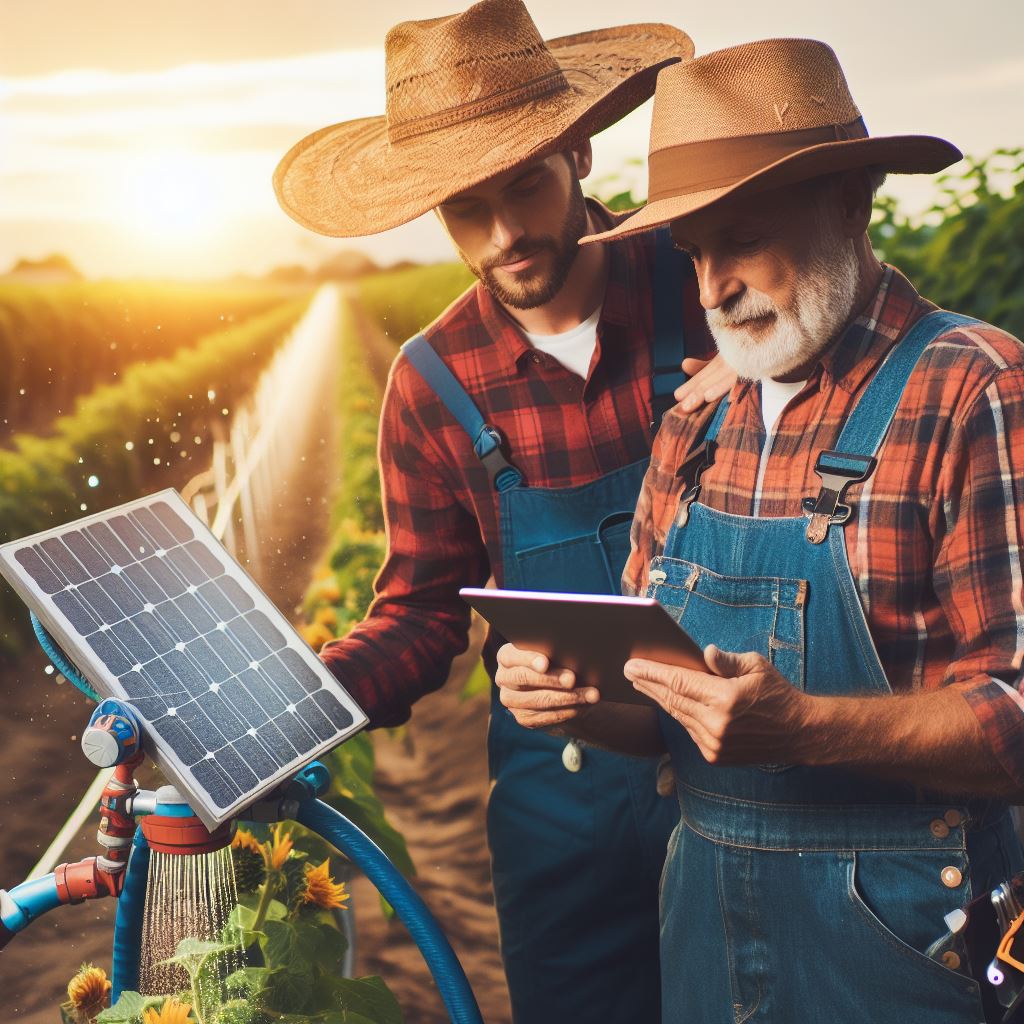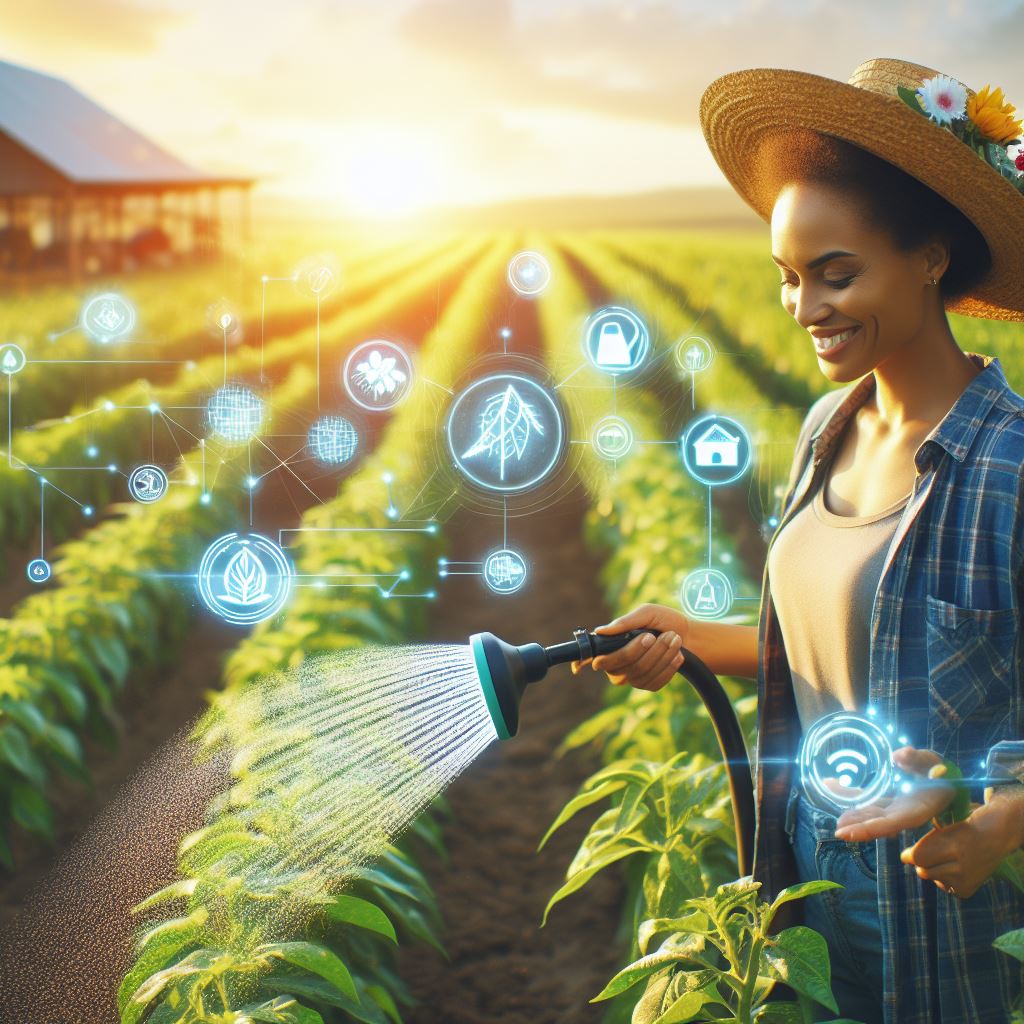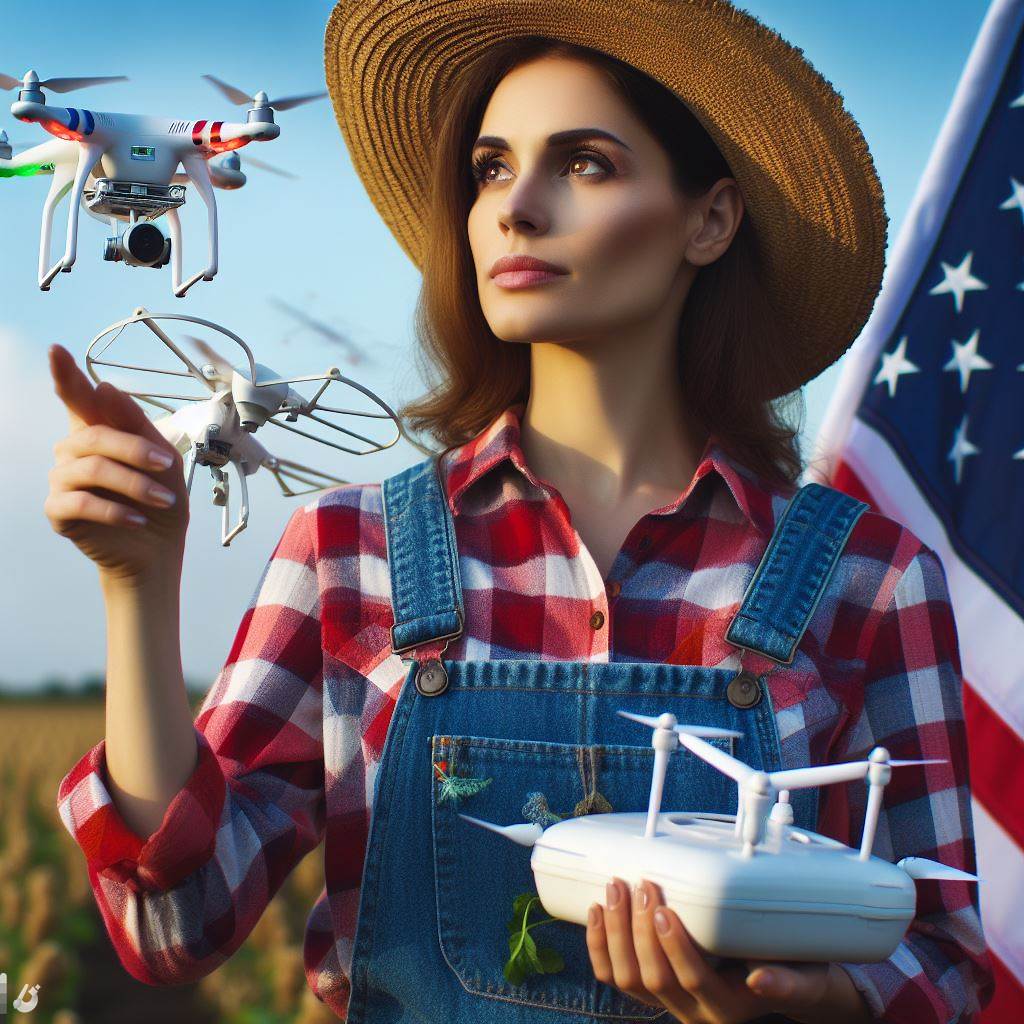Introduction
Importance of irrigation in agriculture
Solar Powered Irrigation plays a crucial role in ensuring the productivity and sustainability of agricultural systems.
It helps in providing water to crops during dry spells and increasing yields.
Growing interest in solar-powered irrigation systems
In recent years, there has been a significant increase in the popularity of solar-powered irrigation systems.
These systems harness solar energy to pump water, offering a sustainable and cost-effective alternative to traditional irrigation methods.
This type of system has numerous advantages.
Firstly, they reduce dependence on fossil fuels, minimizing greenhouse gas emissions and mitigating climate change.
Additionally, they provide a solution for remote areas with limited access to electricity, expanding irrigation possibilities.
The technology behind these systems is simple yet innovative.
Solar panels capture sunlight and convert it into electricity, which powers the water pumps.
This eliminates the need for expensive and polluting diesel or electric-powered pumps.
Moreover, these systems are versatile and adaptable to various scales of farming.
Small-scale farmers can benefit from portable solar pumps, while larger-scale operations can utilize larger arrays of solar panels and high-capacity pumps.
These systems also offer financial benefits to farmers.
Once the initial investment is made, the ongoing operation costs are significantly lower compared to traditional irrigation methods.
They also reduce the risk of rising fuel prices, ensuring long-term affordability.
Transform Your Agribusiness
Unlock your farm's potential with expert advice tailored to your needs. Get actionable steps that drive real results.
Get StartedBasically, the importance of irrigation in agriculture cannot be overstated, and the increasing interest in these systems showcases the shift towards sustainable practices.
These systems offer environmental, social, and economic benefits, making them a promising solution for modern agriculture.
What is solar-powered irrigation?
Solar-powered irrigation is a method of supplying water to fields or crops using solar energy as the primary power source.
Definition
Solar-powered irrigation refers to the use of solar energy to pump water and distribute it to crops for efficient irrigation purposes.
Components of a solar-powered irrigation system
- Solar panels: These capture sunlight and convert it into electrical energy.
- Pump: It draws water from the source and delivers it to the fields.
- Controller: It regulates the functioning of the system and ensures optimal water distribution.
- Storage system: It is used to store excess water during peak sunlight hours for later use.
- Distribution system: It transports water from the pump to the fields through pipes or channels.
How it works
- Solar panels absorb sunlight, converting it into direct current (DC) electrical energy.
- DC energy flows into an inverter, which converts it into alternating current (AC) energy.
- AC energy powers the pump, which draws water from the source, such as a well or reservoir.
- The water is then distributed to the fields through a network of pipes or channels.
- A controller monitors and adjusts the system based on factors like soil moisture levels and weather conditions.
- Excess water, not immediately required, is stored in a storage system for later use during periods of low sunlight.
Benefits of solar-powered irrigation
- Energy independence: Solar power reduces reliance on traditional energy sources, making farmers self-sufficient.
- Cost savings: Solar energy is renewable and free, reducing operating costs in the long run.
- Environmental sustainability: This type of irrigation eliminates fuel consumption and reduces greenhouse gas emissions.
- Scalability: The system can be easily expanded or modified to meet changing irrigation needs.
- Increased productivity: Efficient and reliable water supply improves crop yield and quality.
Challenges and considerations
- Initial investment: Installing a solar-powered irrigation system requires upfront costs for equipment and installation.
- Maintenance: Regular monitoring and maintenance are necessary to ensure optimal system performance.
- Water availability: Solar-powered irrigation relies on access to a reliable water source, such as a well or river.
- System sizing: Matching the system capacity to the water demands of the crops and field size is crucial.
- Technical knowledge: Farmers may need training or assistance to understand and operate the system effectively.
Solar-powered irrigation offers a sustainable solution for efficient water management in agriculture.
By harnessing the power of the sun, farmers can reduce their dependency on fossil fuels, cut costs, and increase productivity in an environmentally friendly manner.
Read: Smart Sensors: Changing Farm Water Use
Benefits of Solar-Powered Irrigation
Environmental Benefits
- Solar-powered irrigation reduces reliance on fossil fuel-powered pumps, reducing carbon emissions.
- It helps in conserving water by implementing smart irrigation practices and reducing water wastage.
- By using renewable energy, solar-powered irrigation contributes to the global effort of mitigating climate change.
- The use of solar energy does not contribute to air and water pollution, ensuring a cleaner environment.
Cost Savings
- Solar-powered irrigation systems reduce energy costs as they rely on free solar energy, minimizing electricity bills.
- Farmers can save on operational costs by reducing fossil fuel usage and the associated expenses.
- The maintenance and operational costs of solar-powered systems are relatively lower compared to traditional irrigation methods.
- Long-term savings can be achieved as solar panels have a lifespan of 25 years or more with minimal maintenance.
Increased Efficiency
- Solar-powered irrigation systems can be designed to match the specific water requirements, optimizing water distribution.
- Smart control systems enable remote monitoring and management, improving overall efficiency and reducing labor requirements.
- These systems can adapt to various weather conditions and adjust irrigation schedules accordingly, maximizing water usage efficiency.
- Solar-powered pumps typically provide a steady water supply, ensuring consistent irrigation for crops and improved yields.
Resilience to Power Outages
- Solar-powered irrigation systems continue to function during power outages since they are not dependent on the electrical grid.
- This resilience ensures uninterrupted water supply to crops, mitigating the risk of crop failure during critical periods.
- In remote and rural areas with unreliable power supply, solar-powered systems provide a reliable and consistent water source.
- Farmers are not susceptible to rising fuel prices or electrical supply disruptions, increasing their overall productivity and profitability.
In short, solar-powered irrigation offers several benefits that make it an attractive and sustainable solution for agricultural water needs.
Its environmental advantages contribute to a cleaner and greener planet, while cost savings and increased efficiency benefit farmers economically.
Additionally, the resilience of solar-powered systems to power outages ensures reliable irrigation and improved crop yields.
Embracing solar-powered irrigation can lead to a more sustainable and resilient agricultural sector.
Read: AI in Farming: Precision Ag Revolution
Types of solar-powered irrigation systems
Solar-powered irrigation systems have revolutionized agricultural practices by utilizing renewable energy sources for irrigation purposes.
These systems harness the power of the sun to pump water onto fields, ensuring a more efficient and sustainable method of watering crops.
Surface water pumping systems
Surface water pumping systems are solar-powered irrigation systems that rely on capturing surface water sources.
These systems often use floating solar panels or solar pumps to extract water from rivers, lakes, or reservoirs.
The solar energy collected powers the pumps, enabling the water to be distributed onto the fields for crop irrigation.
This method is particularly beneficial in areas with abundant surface water sources.
Groundwater pumping systems
Groundwater pumping systems, on the other hand, extract water from underground sources using solar energy.
Solar-powered pumps are installed in wells to bring up water for irrigation.
These systems are especially useful in areas where surface water may be scarce or inaccessible.
By harnessing solar power, farmers can access groundwater without relying on expensive and environmentally damaging fossil fuel-powered pumps.
Pivot systems
Pivot systems are another type of solar-powered irrigation system commonly used in large agricultural fields.
These systems consist of a central pivot point from which sprinklers extend in a circular motion.
Showcase Your Farming Business
Publish your professional farming services profile on our blog for a one-time fee of $200 and reach a dedicated audience of farmers and agribusiness owners.
Publish Your ProfileThe sprinklers are powered by solar energy, ensuring that water is evenly distributed across the field.
Pivot systems are ideal for irrigating large areas and can significantly reduce water and energy wastage compared to traditional irrigation methods.
Drip irrigation systems
Drip irrigation systems, on the other hand, provide water directly to the plant’s roots, reducing water loss through evaporation or runoff.
Solar panels power the pumps that deliver water through a network of tubes and emitters placed near the plants.
This method allows for precise water delivery, promoting healthier plant growth while conserving water resources.
Drip irrigation systems are particularly effective in arid regions where water scarcity is a significant concern.
By incorporating solar-powered irrigation systems into agricultural practices, farmers can benefit from reduced operating costs and environmental impact.
These systems eliminate the need for diesel-powered pumps, reducing dependence on fossil fuels and lowering carbon emissions.
Additionally, solar-powered irrigation systems offer greater flexibility and reliability, allowing farmers to irrigate their crops even in remote areas without access to traditional power sources.
Generally, solar-powered irrigation systems have introduced a sustainable and efficient approach to water management in agriculture.
Surface water pumping systems, groundwater pumping systems, pivot systems, and drip irrigation systems are all examples of solar-powered solutions that cater to different farming needs.
By embracing these technologies, farmers can enhance crop productivity while contributing to a greener and more sustainable future.
Read: Tech Trends: Agri Robotics in 2024
Factors to consider when implementing solar-powered irrigation
Solar-powered irrigation systems have gained popularity due to their eco-friendly and cost-effective nature.
However, before implementing such a system, several factors need to be considered.
These include solar resource availability, water source and quality, crop water requirements, system size and capacity, and maintenance and operation.
Solar resource availability
- Location: The solar resource availability varies depending on the geographical location. Areas with high solar radiation are ideal for solar-powered irrigation systems.
- Seasonal variations: Solar radiation also fluctuates throughout the year. It is essential to assess the availability of solar energy during different seasons to ensure uninterrupted operation of the system.
- Shading: Trees, buildings, or any other obstructions that can cast shadows may limit the solar resource availability. It is crucial to select a location free from shading for optimum performance.
Water source and quality
- Accessibility: The proximity of the water source to the system determines the efficiency and ease of operation. The water source should be easily accessible for smooth functioning.
- Water quality: The quality of water used for irrigation impacts the performance and longevity of the system. Poor water quality may cause clogging or corrosion, leading to maintenance issues.
- Water availability: Sufficient water availability is necessary for proper irrigation. The solar-powered system should be designed considering the water availability in the region to avoid water shortage.
Crop water requirements
- Water demand: Different crops have varying water requirements. It is essential to determine the water demand of the crops to design a solar-powered irrigation system that fulfills their needs adequately.
- Evapotranspiration: Estimating evapotranspiration helps in determining the irrigation frequency and duration. This data assists in sizing the solar-powered system appropriately.
- Irrigation techniques: Different irrigation techniques, such as drip irrigation or sprinklers, have varying water application rates. The system design should be compatible with the chosen irrigation technique.
System size and capacity
- Irrigation area: The size of the area to be irrigated directly impacts the system size and capacity. Larger areas require larger solar panels and storage capacities.
- Efficiency: The efficiency of this system affects its overall performance. Factors like pump efficiency, solar panel efficiency, and control systems should be considered to ensure optimal output.
- Storage capacity: Sizing the storage capacity adequately ensures a continuous water supply even during non-sunny periods or at night. Consider the daily water demand and solar resource availability when determining the storage capacity.
Maintenance and operation
- Training and knowledge: Adequate training and knowledge about the solar-powered irrigation system are crucial for its efficient operation. Users should be well-versed in system maintenance and troubleshooting.
- Cleaning and inspection: Regular cleaning of solar panels and inspection of system components are necessary to maintain optimal performance. Any faults or damages should be addressed promptly.
- Spare parts availability: Availability of spare parts is essential for quick repairs and replacements. It is advisable to select a system with spare parts readily available in the local market.
Essentially, before implementing this system, it is crucial to consider various factors.
Solar resource availability, water source and quality, crop water requirements, system size and capacity, and maintenance and operation are all critical considerations.
Proper evaluation of these factors will ensure the successful implementation and long-term sustainability of the solar-powered irrigation system.
Read: Precision Agri: GPS Guided Farming Explained

Case studies
Example 1: Solar-powered irrigation in a small-scale farm
Solar-powered irrigation has shown significant benefits in small-scale farms, enabling them to increase crop production and improve overall efficiency.
In a case study conducted on a small-scale farm in rural Kenya, these systems were installed to enhance water access and eliminate the need for manual labor.
With solar panels installed to power the irrigation pumps, the farm experienced improved water management and reduced reliance on unpredictable rainfall.
This system allowed the farmer to water crops more efficiently, ensuring that each plant received the necessary amount of water.
Not only did this increase crop yield and quality, but it also saved significant amounts of water compared to traditional irrigation techniques.
Example 2: Solar-powered irrigation in a large-scale farm
The application of solar-powered irrigation has also proven to be beneficial in large-scale farms, reducing costs and increasing sustainability.
In a case study conducted on a large-scale farm in California, solar-powered irrigation systems were implemented to address water scarcity and rising energy costs.
By utilizing solar energy, the farm was able to reduce its reliance on fossil fuels and contribute to environmental conservation.
This system enabled the farm to irrigate larger areas of land more effectively and economically.
As a result, the farm experienced increased productivity and profitability while minimizing its carbon footprint.
Success stories and lessons learned
Various success stories and lessons learned from the implementation of solar-powered irrigation highlight its potential and importance.
One success story comes from a farmer in India who was able to transform his arid piece of land into a flourishing farm using this type of irrigation.
By harnessing the power of the sun, he was able to overcome water scarcity and increase crop yield, thereby improving his livelihood.
Lessons learned from these case studies emphasize the need for proper system design and maintenance to ensure optimal performance.
Additionally, financial incentives and government support play a critical role in promoting the adoption of solar-powered irrigation systems.
These success stories and lessons learned collectively demonstrate the transformative impact of solar-powered irrigation on agriculture.
In essence, case studies exemplify the benefits and potential of this irrigation in both small-scale and large-scale farms.
The success stories and lessons learned highlight the crucial role of solar energy in improving water management, increasing productivity, and achieving sustainability in agriculture.
Explore Further: Precision Agri: Boosting Yield Sustainably
Challenges and Limitations
Achieving widespread adoption of these systems is not without its challenges and limitations. These include:
Showcase Your Farming Business
Publish your professional farming services profile on our blog for a one-time fee of $200 and reach a dedicated audience of farmers and agribusiness owners.
Publish Your ProfileInitial investment costs
- The high upfront cost of installing solar panels and related equipment can discourage farmers from adopting this technology.
- Acquiring the necessary funds for investment and navigating financial barriers can be a significant hurdle for farmers.
- Cost-sharing models and access to low-interest loans can help mitigate the initial investment burden.
Technical limitations
- Solar-powered irrigation systems are dependent on the availability of sunlight, which can vary due to weather conditions or seasonal changes.
- Inefficient solar panel placement or lack of proper maintenance can lead to suboptimal performance.
- Ongoing monitoring and regular repairs are essential to ensure the system operates at its maximum potential.
Regulatory and policy hurdles
- In some regions, there may be regulatory barriers or outdated policies that impede the adoption of solar-powered irrigation systems.
- Unclear rules regarding permits, installation procedures, and grid connectivity can create obstacles for farmers.
- Collaboration between governments, agricultural organizations, and technical experts is necessary to address these hurdles and update policies.
Potential impact on local water resources
- Solar-powered irrigation systems can increase water extraction from local sources, potentially straining already stressed water resources.
- Without proper management and controls, excessive pumping can lead to groundwater depletion and negatively impact ecosystems.
- Implementing water-efficient irrigation techniques, like drip irrigation, can help minimize water usage and mitigate potential resource depletion.
Despite these challenges and limitations, the benefits of these systems are indisputable.
Finding solutions to overcome these obstacles can help unlock the technology’s full potential and promote sustainable agriculture.
Addressing the challenges
By addressing the initial investment costs through financial support mechanisms and promoting cost-sharing models, farmers can be encouraged to adopt these systems.
Education and training programs on proper installation and maintenance can also address technical limitations.
Advocacy for policy reforms and streamlined regulations is critical to removing barriers and creating an enabling environment for solar-powered irrigation deployment.
Governments should work hand in hand with stakeholders to update policies and ensure clarity in installation procedures and permit requirements.
To mitigate the potential impact on local water resources, farmers should implement water-efficient irrigation techniques and adopt smart water management practices.
Monitoring and regulating water extraction rates can help prevent over-exploitation and preserve ecosystem integrity.
While overcoming these challenges may require significant effort, the long-term benefits are worth pursuing.
These systems have the potential to revolutionize agricultural practices, reduce reliance on unsustainable energy sources, and contribute to a more sustainable and resilient food system.
Future prospects and advancements in solar-powered irrigation
Technological advancements
- Solar-powered irrigation systems are expected to experience continuous improvements and upgrades.
- New innovations in solar panel efficiency will enhance the performance of these systems.
- Advancements in battery technology will allow for better storage and utilization of solar energy.
- Intelligent control systems will be developed to optimize water usage and ensure maximum efficiency.
- Sensor technology will be integrated to monitor soil moisture levels and adjust irrigation schedules accordingly.
- Nanotechnology and robotics may play a role in creating more autonomous and precise irrigation systems.
- Research and development will focus on increasing the durability and longevity of this system components.
- Machine learning and artificial intelligence will be utilized to create self-learning systems that adapt to environmental conditions.
- Collaborations with other sectors such as aerospace and defense may bring further technological advancements to this system.
- Remote monitoring and control capabilities will become more sophisticated, allowing farmers to manage their irrigation systems from anywhere.
Integration with smart farming techniques
- Solar-powered irrigation will be seamlessly integrated with other smart farming technologies.
- Data collected from sensors and IoT devices will be used to optimize irrigation schedules and water usage.
- Irrigation systems will communicate with other farming equipment to enhance overall farm management.
- Real-time data analysis will provide valuable insights for decision-making and resource allocation.
- Integration with precision farming techniques will ensure that water is delivered precisely where and when it is needed.
- Smart farming platforms will offer farmers comprehensive control over their irrigation systems and other farming operations.
- Solar-powered irrigation will be a key component in creating sustainable and environmentally friendly farming practices.
- Improved efficiency and resource management will lead to higher crop yields and reduced water wastage.
- Farmers will have access to detailed analytics and recommendations to optimize their irrigation strategies.
- Smart farming techniques will empower farmers to make data-driven decisions for improved productivity and profitability.
Potential for scalability and widespread adoption
- Solar-powered irrigation systems have immense potential for scalability and widespread adoption.
- As technology advances and costs decrease, these systems will become more accessible to farmers globally.
- The affordability of solar panels and batteries will make this type of irrigation a viable option for small-scale farmers.
- Government incentives and subsidies will encourage the adoption of this systems.
- Increased awareness and education about the benefits of this irrigation will drive its widespread adoption.
- Large-scale agricultural businesses will capitalize on the cost savings and environmental benefits of solar-powered irrigation.
- Partnerships between technology companies, agricultural organizations, and governments will accelerate the adoption process.
- Research institutions and organizations will continue to explore the feasibility and scalability of solar-powered irrigation.
- International collaborations and knowledge sharing will foster the global implementation of solar-powered irrigation systems.
- Widespread adoption of solar-powered irrigation will contribute to sustainable agriculture practices and water conservation efforts.
In a nutshell, the future of solar-powered irrigation looks promising with continuous technological advancements, integration with smart farming techniques, and the potential for scalability and widespread adoption.
As these systems become more efficient, accessible, and cost-effective, they will revolutionize farming practices, ensuring sustainable, high-yield production while minimizing environmental impact.
Learn More: Harvest Tech: Robotic Arms in Use
Explore Further: Robotic Tech in Agriculture: A Deep Dive
Conclusion
Recap of the benefits and challenges of solar-powered irrigation
As covered in this deep dive, this type of irrigation offers numerous benefits like reduced electricity costs, lower carbon footprint, and water access for remote farms lacking grid connectivity.
However, high upfront capital costs of solar equipment and energy storage systems poses a key barrier, especially for smallholder farms.
Call to action for farmers to consider solar-powered irrigation
It is vital that farmers actively assess the long-term cost-savings and sustainability that solar-irrigation systems provide against the substantial initial investment required.
Governments can also provide subsidies and incentives to farmers adopting renewable energy-based irrigation to offset expenses.
Academic institutions have a crucial role to play in raising awareness of solar irrigation through agricultural extension programs.
Importance of continued research and development in the field
Ongoing research addressing efficiency limitations of existing PV technologies, innovative panel materials like flexible thin-film solar sheets, and new battery storage solutions will expand access for more farms globally.
Energy assessment tools that help customize solar irrigation systems based on crop water requirements and local conditions will further drive adoption.
Transitioning a significant share of conventional electric/diesel powered irrigation to solar energy is critical to building climate-resilient, future-proof agriculture.
Unlocking financing mechanisms and public-private partnerships is key to overcoming barriers as the world feeds more people sustainably this century.
The solar irrigation pathway ahead promises to be challenging but transformational.




